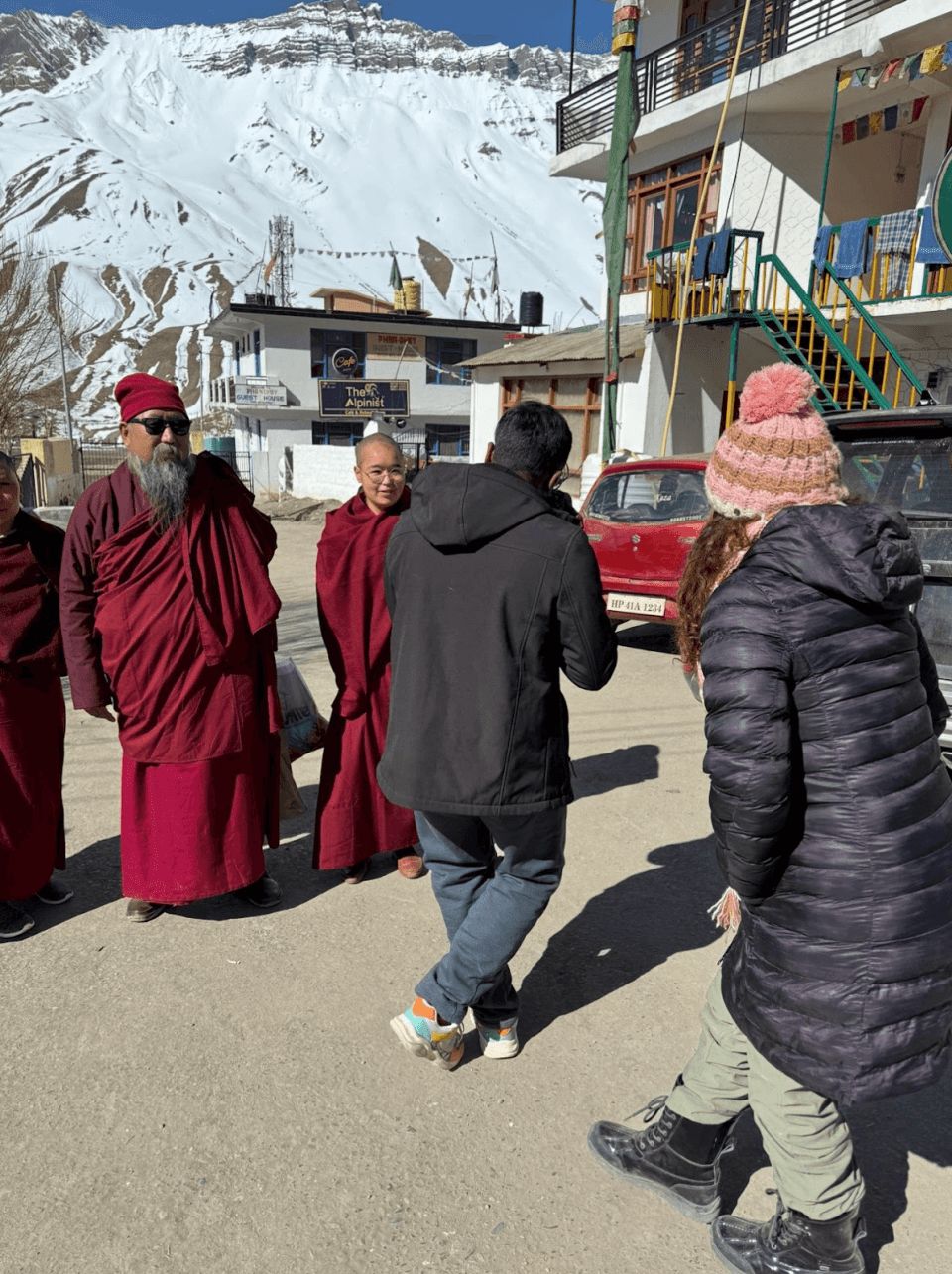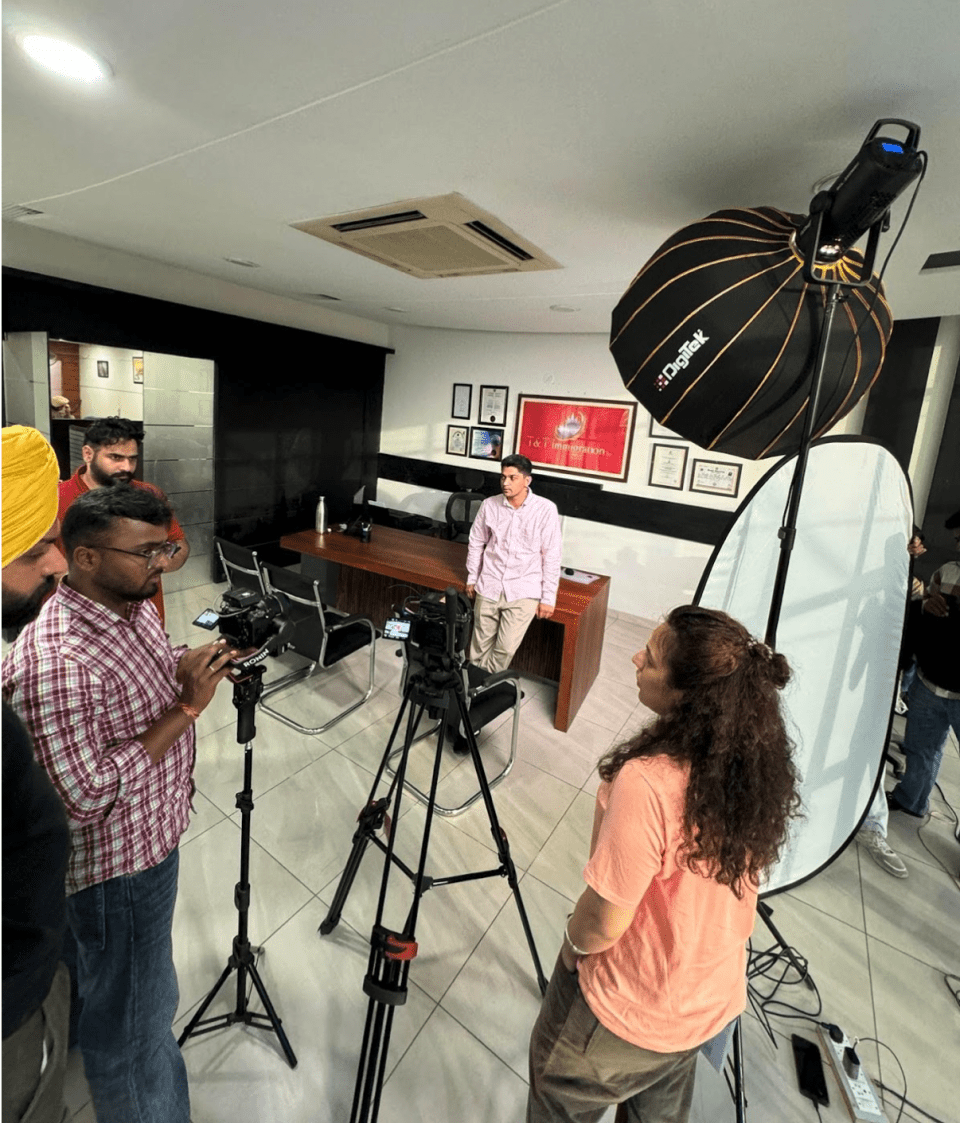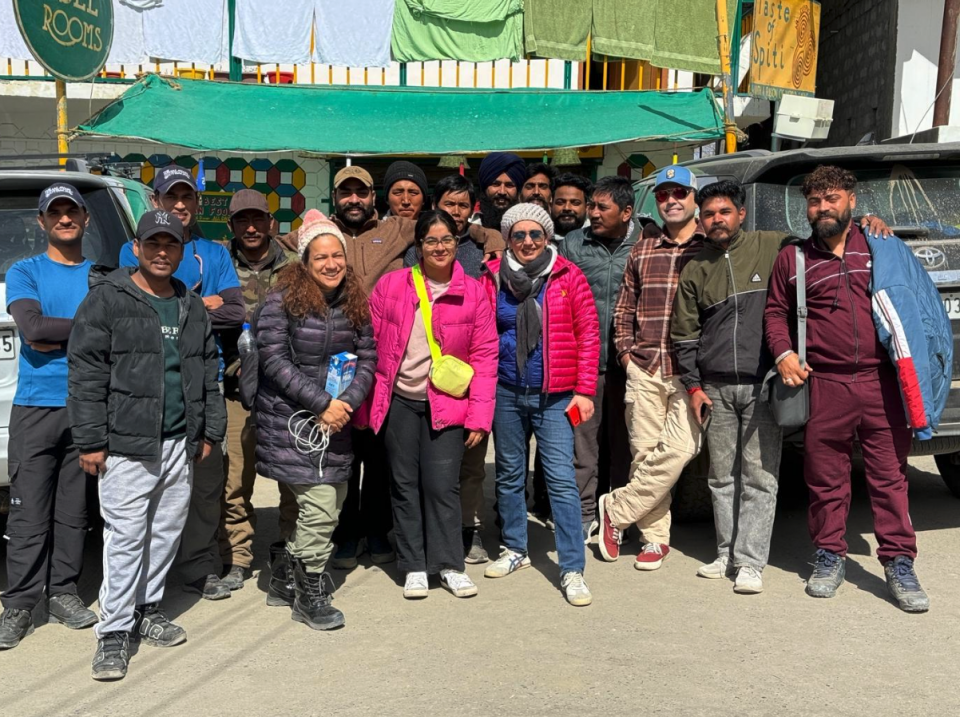NYFA Alum Rose Gill Discusses Her Filmmaking Journey and the Making of Raah-e-Nanak
Rose Gill is a filmmaker and writer from Punjab, India, whose journey to storytelling began with a childhood love for poetry, books, and cinema. After years dedicated to India’s civil services, she rediscovered her creative path during the pandemic through an online screenwriting course at the New York Film Academy. That spark led her to NYFA in Los Angeles, where she embraced filmmaking fully. Since then, her debut documentary Raah-e-Nanak and award-winning screenplay have earned international acclaim, reflecting her passion for stories rooted in compassion, culture, and everyday humanity.
NYFA Alumni Network: Can you tell us a bit about yourself, where you're from, and what brought you to New York Film Academy?
Rose Gill (R.G.): I’m a filmmaker and writer from Punjab, a small province in Northern India.
I’ve always been that creative kid—writing poetry and stories since I was little, devouring books like snacks, and completely obsessed with cinema. Growing up, all of this created a kind of magic around me—a world where I felt most alive. Eventually, I realized that I didn’t just want to admire stories; I wanted to create them. That’s when the dream of becoming a director took root.
But life had other plans first. My father always encouraged me and my sisters to be strong, independent women. In India, the civil services are seen as one of the most powerful and prestigious careers, and he dreamed of me becoming an officer. So I put my creative dreams on pause and plunged into the intense journey of cracking the civil services exam—12-hour study days, year after year. It was tough, but I gave it my all and eventually made it through.
Once I achieved what my parents hoped for, I felt it was time to return to my first love—storytelling. The pandemic surprisingly gave me that window. During COVID, I enrolled in NYFA’s online screenwriting course, and I loved every second of it. I even completed my first screenplay in those classes. That experience reignited something in me, and after the pandemic, I took a sabbatical from work and flew to Los Angeles to study film direction at NYFA.
Joining NYFA was one of the best decisions of my life. I had some of the most creatively fulfilling and joyful moments there—learning, filming, collaborating with people from all over the world. It gave me both the tools and the confidence to bring my stories to life.
 NYFA Alumni Network: What projects have you worked on since graduating? Have you won any awards or been showcased in any festivals or competitions?
NYFA Alumni Network: What projects have you worked on since graduating? Have you won any awards or been showcased in any festivals or competitions?
R.G: Since graduating from NYFA, my main focus has been my debut documentary Raah-e-Nanak: A Journey Through Everyday Sufism. It’s a deeply personal film rooted in the philosophy of Guru Nanak and how his message of love, compassion, and service still quietly lives on in everyday acts. It’s already begun its festival journey, and I’ve been truly humbled by the response.
But even before Raah-e-Nanak, the very first screenplay I wrote—with the help and mentorship I received at NYFA—started creating magic of its own. That script has now travelled more than I ever imagined. It won Best International Screenplay at the Austin Spotlight Film Festival in Texas, made it to the Top 100 in the New York Screenwriting Competition, and was a finalist in an international contest in Spain. It’s also been officially selected in festivals in Italy and beyond. So in a way, that one story has already taken me to Texas, Spain, and Italy—which allowed me to reunite with old friends I made at NYFA, and explore the places like León, Segovia, and Astorga, Lake Como, Torino, Orbassano, Milan, Venice, Austin, New York etc.
Right now, I’m also developing a feature film project set between Spain and Punjab. It explores cross-cultural love and identity—stories that are close to my heart. Storytelling is a long road, but I feel like I’ve truly begun walking it now.
NYFA Alumni Network: Tell us more about Raah-e-Nanak & how did the film come about?
R.G: Raah-e-Nanak is a deeply personal film— It’s a walk through the soul of Punjab, and through the timeless message of Guru Nanak. (first guru of Sikhs).
It began with my younger brother Haider. He has always had this way of being kind without ever announcing it. He would go about helping people, talking to children on the street with warmth and dignity, offering support to strangers without expecting anything in return. His natural compassion is what first moved me.
I was speaking about him one day with Bicky Singh, the founder of SikhLens Voices (producer of the film), and he was the one who said, “Why aren’t you documenting what your brother is doing?” That suggestion planted the seed. It made me reflect on how rare and beautiful such selfless actions are, especially in today’s chaotic, fast-paced, and often disconnected world. We always hear stories of conflict and negativity, but there are people out there who are blessings in their communities, silently making a difference. Their stories matter too.
Once I sat down to write, the story just flowed. I knew I didn’t want this to be a traditional documentary about religion or grand figures. I wanted it to be a journey through everyday kindness. The film travels from Sangrur, Punjab to the remote Himalayan village of Kaza in Spiti Valley. Along the way, it highlights small, powerful gestures of compassion that transcend region, language, and belief—simple acts that carry the spirit of Guru Nanak’s teachings of love, equality, and service.
My brother’s instinctive generosity became the emotional spine of the film. And as we travelled, we discovered stories that were all deeply human and spiritual, in the most humble way. It’s a film that doesn’t preach—it observes. It listens. And it shines a light on the luminous side of humanity that often gets overlooked.
I think Raah-e-Nanak was a film waiting to happen. It just needed the right moment and the right nudge—and I’m so grateful both came along.

NYFA Alumni Network: Were there any challenges when making the film?
R.G: Oh, so many! Honestly, every single day on Raah-e-Nanak brought a new challenge, a new lesson—and in some ways, a small miracle.
To begin with, Raah-e-Nanak wasn’t backed by a big crew or a large budget. It was an independent passion project from the very beginning. We were shooting in remote locations at an altitude of 8000 m—places like Spiti in the Himalayas, where oxygen levels drop, roads vanish without warning, and temperatures can go from sunny to snowstorm in hours. Managing logistics in such terrains was incredibly demanding. There were days when we had no access to basic amenities, and we just had to figure things out on the go.
At one point, I even had to let go of the line producer because instead of helping, things were getting messier. So I ended up coordinating a lot of the production on my own. It was tough, but I think it gave me a kind of creative control that shaped the soul of the film.
Except for our DOP, every single person on the crew was a first-timer. I was stepping into the shoes of a writer-director for the very first time. The production team had little to no on-ground experience, and we were all learning as we went along. Our editors were college-going boys—young, full of energy, and figuring it out just like the rest of us. The narration and music were also done by first-timers, but they poured their hearts into it and did a marvelous job. In fact, their rawness added something beautifully honest to the film.
And then there was the biggest challenge of all—working with real people who weren’t actors. These were everyday individuals with extraordinary hearts, but no training or comfort in front of the camera. Convincing them to open up, especially in deeply emotional moments, required immense trust-building.
The most personal challenge was convincing my younger brother—who is at the core of this story—to let me document his philosophy, his actions, and eventually, to come on camera. He's someone who believes in doing, not in showing. So asking him to share his world with the lens wasn’t easy. But once he agreed, everything started falling into place.
So yes, from day one till the day of the film’s release, Raah-e-Nanak was a string of battles—but beautiful ones. Each obstacle brought a new kind of growth. And I think that’s what made the process—and the final film—so special. It was imperfectly perfect. Just like life.

NYFA Alumni Network: What do you hope the audience takes away from the film?
R.G: I honestly just want people to feel something shift inside them when they watch Raah-e-Nanak. You know, in today’s world—with all the noise, conflict, and constant rush—we often forget the silent strength of kindness. This film is my gentle reminder that love and compassion still exist, quietly and powerfully, in the most unexpected corners of our world.
These aren’t big gestures. These are small, everyday acts of humanity that restore your faith—people who give without asking, who serve without needing to be seen. I want the audience to pause and realise that maybe being human is enough. That we don’t need grand narratives to make a difference; even just caring, truly caring, is radical in itself.
And honestly, the kind of responses we received after the premiere just made my heart full. I remember people walking out with moist eyes. Some came to me and said they never thought they’d be introduced to Guru Nanak’s path in this way—that it felt so real, so alive. One woman said, “I never knew it was this simple to be kind in everyday life.” A few even took down contact details of the people featured in the film—those who are doing incredible community work—because they genuinely wanted to support them in whatever way they could.
There was this one moment I’ll never forget—my sister’s friend, who’s going through one of the most difficult phases in her personal life, watched the film quietly. Later, with tears in her eyes, she said, “I think my problems are so small and temporary. This film reminded me that the bigger achievement in life is to bring joy to others by relieving their pain—even in the tiniest way.” That’s when I knew the film had reached where it needed to. Straight to the heart.
If someone walks out of this film and looks at the world a little more softly, or chooses kindness when it’s hard, then I think the story has done its job. I hope it leaves people with warmth, with hope—and maybe with a nudge to notice the "Nanak" is around them. Because He is everywhere. Quietly shaping and saving this world with love.

NYFA Alumni Network: Are you working on any future projects?
R.G: Yes, I am—several, in fact. It feels like after Raah-e-Nanak, the universe gently cracked open and started sending stories my way.
One of the most exciting projects I’m working on is a feature-length fiction film that’s very close to my heart. It’s a story set between Punjab and Spain—born from a space of friendship, shared laughter, and the warmth of cross-cultural connection.
I have six very dear friends in Spain—friends I met during my time at NYFA. We were always together, and it was during those long, immersive days in LA that we first began noticing just how much Punjabis and Spanish people have in common. That realization has stayed with us ever since: both cultures are unapologetically vibrant, full of music, dance, food, big families, louder voices, and even bigger hearts.
The actual idea for the film came to life much later, during a visit to Spain. One afternoon, we were all having lunch in a cozy Madrid kitchen—just eating, laughing, reminiscing—and that old realization bubbled up again. But this time, it hit differently. We looked at each other and said, “Why don’t we make a story out of this? Why don’t we collaborate on something that brings together our worlds?”
That was the seed. From that sun-drenched afternoon in Madrid, the story started to take shape. Since then, we’ve nurtured it into a full-fledged screenplay. It’s ready, and if all goes well, it might go on floors later this year. What makes this even more special is that it's a collaborative labor of love between NYFA alumni from different continents—a project held together by friendship, warmth, and a shared vision.
Alongside that, I’m also developing a short documentary about women in public service in India—something drawn from my own lived experience. I’ve seen how women, often in silence, are shifting deeply patriarchal structures with resilience and grace. I want to bring those silent revolutions to light.
All these projects—though different in scope—are anchored in the same belief: that stories have the power to connect, to heal, and to show us the beautiful common ground we so often overlook.

NYFA Alumni Network: Why is this film important?
R.G: The Selfless Spirit on Screen: A Voice of the Unseen, A Story for the World
“If you can’t see God in all, you can’t see God at all.” — Guru Nanak
I come from Punjab, a land that has witnessed the rise of empires and the pain of partition. It’s also the birthplace of Sikhism—the world’s youngest monotheistic faith—founded by a poet-revolutionary whose teachings continue to guide millions. And yet, our stories often remain unseen, our voices unheard.
Sikhs comprise less than 0.4% of the world’s population, but our impact is far greater—measured not in power or politics, but in service. Wherever there is pain, hunger, or disaster, there’s usually a Sikh quietly working in the background—not for recognition, but because seva (selfless service) is a way of life.
During the pandemic, while the world came to a standstill, Sikh gurdwaras around the globe turned into lifelines—offering food, shelter, and care. These acts were not driven by headlines, but by belief.
I carry that legacy.
I belong to this community.
I am the writer and director of Raah-e-Nanak.
This film was born from a personal calling, but it speaks to something much larger: the urgent need to center compassion in our global narrative. In a time when ‘inclusivity’ is a keyword, we must also make space for voices that don’t always dominate the mainstream. Stories from communities like mine—small in number, but immense in spirit—need to be heard. Not out of tokenism, but because they offer something essential.
Raah-e-Nanak is not a religious film. It is not dogmatic or even strictly spiritual. It is a film about what happens when faith is lived—not preached. It follows Haider, a man who asks no one their religion before he helps them. In the freezing mountains of Spiti, he serves, nourishes, and uplifts. His actions echo Nanak’s teachings. Through him and others like Ishita and the team at Ecosphere, the film reveals how love and service transcend boundaries of religion, geography, and identity.
In Raah-e-Nanak, Punjab’s Sikhism meets Kaza’s Buddhism and Himachal’s Hinduism—not in contrast, but in harmony. That is the heart of the story: that beneath all labels, we are bound by a shared humanity. This film belongs on the world stage. It’s made with the visual storytelling of National Geographic, the emotional depth of Coke Studio, and the timeless narration style of David Attenborough. Yet beyond its cinematic qualities, what makes Raah-e-Nanak important is the voice it carries—a voice rooted in a lesser-seen community, speaking of a world that could be.
We don’t build empires—we build free kitchens.
We don’t seek fame—we seek those in need.
We don’t preach faith—we live it.
This is my voice.
This is my film.
This is the spirit of Nanak on screen.
And in a world that seeks diversity, stories like these are not just important—they are essential.
NYFA Alumni Network congratulates Rose on all her success!

Comments0
Please log in to see or add a comment
Suggested Articles

